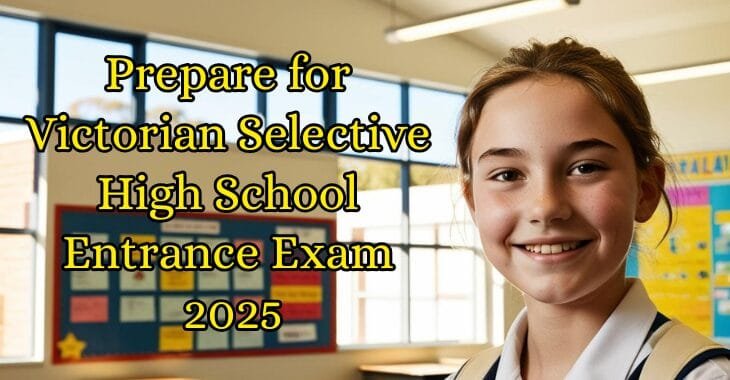
Top Mistakes students make in the Victorian Selective Exam—& How to avoid them?
The Victorian Selective Entry Test is a formidable hurdle for many high-achieving students aspiring to attend one of Victoria’s most prestigious Selective schools. The Victorian Selective aims to identify students with exceptional academic potential. Many students fall short not due to lack of intelligence, but due to common and avoidable mistakes. Understanding these pitfalls and implementing effective strategies can significantly boost an aspiring student’s chances of success.
Conquering the Victorian Selective Test
Let’s take a dive into the top mistakes students make and, more importantly, how to sidestep them.
1. Underestimating the Exam’s Uniqueness
Many students (and parents) approach the Victorian Selective Entry Test like any other school test. They focus on rote learning and simply reviewing the school curriculum.
Why is it a mistake?
The Victorian Selective isn’t just about what you know; it’s about how you think. It comprises Verbal Reasoning, Numerical Reasoning, Reading Comprehension, Mathematics, & Written Expression. These sections test critical thinking, problem-solving, logical deduction, and the ability to process complex information under pressure. Higher-order cognitive skills like these are not always deeply emphasised in regular school assessments.
How to avoid it?
- Recognise the difference: Understand that this exam requires a specific skillset.
- Targeted practice: Focus on practice materials specifically designed for the Victorian Selective. Familiarise yourself with the unique question styles in verbal and numerical reasoning.
- Skill development: Work on improving your ability to identify patterns, solve logical puzzles, and infer meaning from complex texts.
2. Neglecting Strategic Time Management
The Victorian Selective Test is a race against the clock. Students often get bogged down on challenging questions, leading to incomplete sections.
Why is it a mistake?
Each question carries equal weight. Spending five minutes agonising over one difficult question means students sacrificing time that could have been used to answer several easier ones correctly. Panicking when time runs short is also a major performance detractor.
How to avoid it?
- Practice with a timer: Simulating exam conditions during practice is the first and foremost step.
- The ‘skip & return’ strategy: If a question is difficult, make a quick educated guess, mark it, and move on. Return to it later if time permits.
- Pacing awareness: Develop an internal time estimate within yourself for each section. Allot your time per question and stick to it.
- No blank answers: Incorrect answers aren’t penalised. Students must make an educated guess instead of leaving a question blank. A guess has a chance of being right; a blank answer has none.
3. Superficial Reading & Misinterpreting Questions
This mistake often appears in Reading Comprehension, Verbal Reasoning, and even Math problems. Students skim the text or questions and jump to conclusions.
Why is it a mistake?
The exam’s questions are often subtly worded and designed to trick those who don’t read carefully. Missing a negative, misinterpreting a keyword, or failing to understand the exact scope of the question can lead to incorrect answers. This might happen even when one knows the underlying concept.
How to avoid it?
- Active reading: Teach yourself to read slowly and deliberately. Underline or highlight key information, question words (e.g. always, never, except) and any constraints given in the question.
- What is the question actually asking? Before attempting to answer a question, make sure to rephrase it for your better understanding quickly. This ensures you’ve grasped its core intent.
- Process of elimination: Even if you’re unsure of the correct answer, carefully eliminate the wrong options. It improves the chances of choosing the correct answer.
4. Ineffective Practice & Lack of Review
Many students practice, but they don’t learn from their practice. They might complete a practice test, check the score, and move ahead. Understanding their errors and focusing on them to improve is what makes the preparation stand out.
Why is it a mistake?
Simply doing Victoria’s Selective practice tests without getting the mistakes reviewed is like running laps without a coach. It is as if a student is diligently preparing, but not necessarily improving their test-taking technique. Without understanding the why of previously made mistakes, students are likely to repeat the same mistakes.
How to avoid it?
- Take a deep dive into your mistakes: After completing each practice test, review all incorrect answers. Errors must be reviewed keeping in mind the following:
- Was it a conceptual error?
- Was the question misread/misinterpreted ?
- Was it a time management issue?
- Was it a silly mistake?
- Understand the solution: Don’t just look at the correct answer, but take time to understand the reasoning behind it. If need be, take the help of personalised tutoring, Victoria Selective Test prep courses, or other available alternatives.
- Categorise errors: Students must keep a log of their common mistakes. Try to understand if one is consistently struggling with analogies, specific math topics, or inference questions. This helps students identify weaknesses to target.
- Targeted study: Once students identify their weak areas, they can dedicate specific study time to improve those skills or concepts.
5. Neglecting Written Expression
Often, students focus heavily on the multiple-choice sections and give less attention to the Written Expression task.
Why is it a mistake?
Written Expression is a pivotal part of the Victorian Selective with significant weightage. It assesses a candidate’s ability to communicate ideas clearly, creatively, and grammatically under pressure. A well-written essay/short story/piece can make a student stand out amongst other candidates.
How to avoid it?
- Regular writing practice: Practice writing essays, short stories and creative pieces on various prompts within a time limit.
- Focus on Structure & Clarity: Ensure writing pieces have a clear introduction, well-developed body with paragraphs, and an impactful conclusion. Use a diverse yet lucid vocabulary with correct grammar and punctuation.
- Seek feedback: Ask teachers, tutors, or knowledgeable adults to review your writing. Take constructive criticism and learn to incorporate feedback into future practice sessions
- Brainstorming strategies: Learn to do a quick brainstorming of ideas and outline key points before you start writing. Save precious time and get a coherent, cohesive and well-written piece with this practice.
The Victorian Selective Entry Test is certainly challenging but highly conquerable with the right approach. A well-focused and smartly planned preparation with Selectivetrial improves their performance manifold.
The Victoria Selective Entry Test is your child’s gateway to exciting educational opportunities. Let Selectivetrial be the torchbearer in your child’s road to success! Explore more related details on our Victorian Selective High School Test- 2026 page.
Frequently Asked Questions (FAQs)
1. What is the Victorian Selective Test 2026 date?
The Victorian Selective School Test 2026 for 2027-entry is likely to take place in June 2026, following the past year’s patterns.
2. What is the best Victoria Selective Test practice resource?
Specially designed customisable prep courses, practice tests, and sample questions for the Victorian Selective Test from Selectivetrial are one of the most trusted online platforms.






